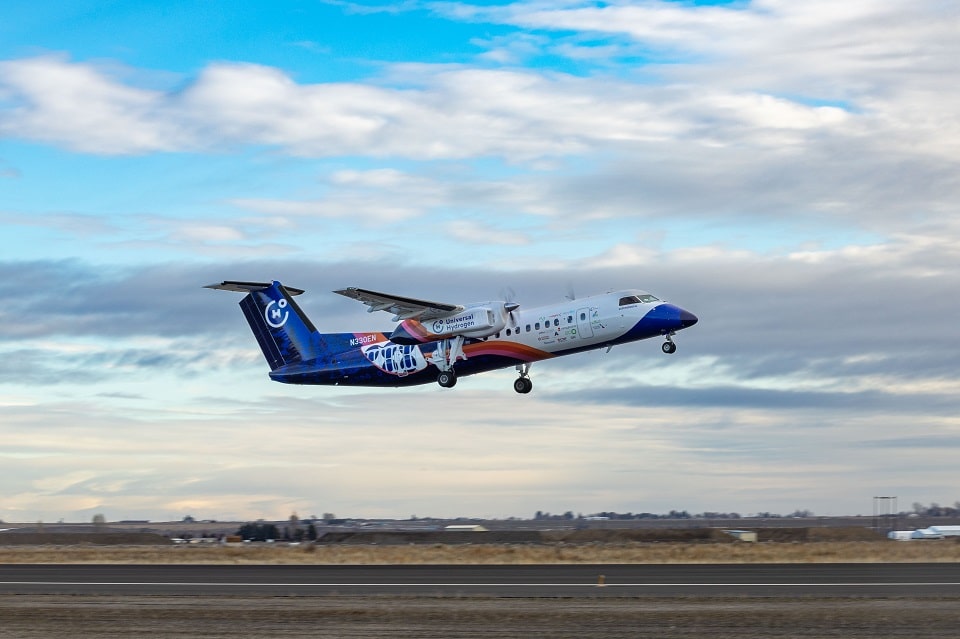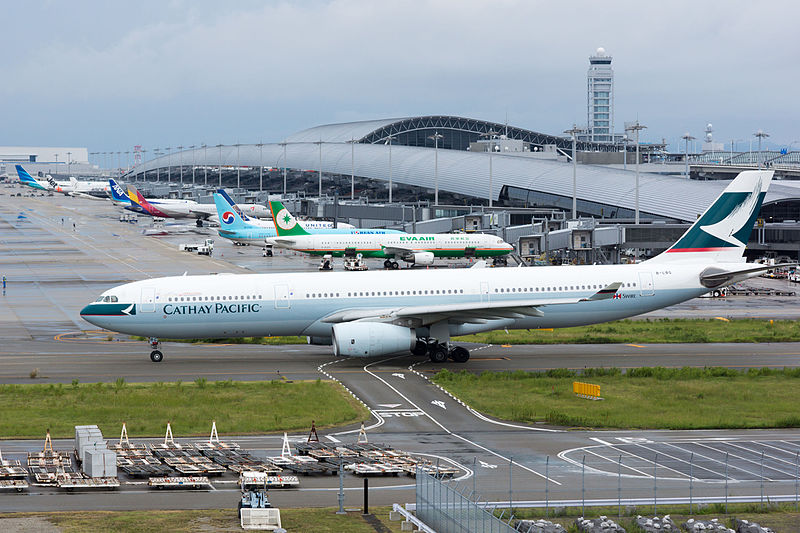Airlines
Universal Hydrogen Successfully Completes First Flight of Hydrogen Regional Airliner

Universal Hydrogen Co., flew a 40-passenger regional airliner using hydrogen fuel cell propulsion. The airplane, nicknamed Lightning McClean, took off at 8:41am PST from Grant County International Airport (KMWH) and flew for 15 minutes, reaching an altitude of 3,500 MSL. The flight, conducted under an FAA Special Airworthiness Certificate, was the first in a two-year flight test campaign expected to culminate in 2025 with entry into passenger service of ATR 72 regional aircraft converted to run on hydrogen.
Universal Hydrogen receives approval from FAA to begin flight tests(Opens in a new browser tab)
Representatives from Connect Airlines and Amelia, the US and European launch customers for the hydrogen airplanes, respectively, were on hand to witness the historic flight. The company has a rapidly growing order book, today totaling 247 aircraft conversions from 16 customers worldwide, totaling over $1 billion in conversions backlog and over $2 billion in fuel services over the first ten years of operation.
The company’s powertrain is built around Plug Power’s ProGen family of fuel cells specially modified for aviation use. One of the unique aspects of the design is that the powertrain does not use a battery—the fuel cells drive the electric motor directly—drastically reducing weight and cost. The motor, a modified magni650 electric propulsion unit, and power electronics were supplied by Everett-based magniX. Seattle-based AeroTEC assisted with engineering efforts, including design of the modified nacelle structure, aircraft systems design and integration, as well as aircraft modifications and installation of the Universal Hydrogen powertrain onto the flight test aircraft, accomplished in less than 12 months.
Airbus reveals hydrogen-powered zero-emission engine(Opens in a new browser tab)
The hydrogen-powered airplane is not just a revolutionary new product; it is a symbol of hope and progress, a beacon of light in a world that desperately needs it. Today marks a new chapter in the history of aviation and the fight against climate change. Universal Hydrogen is leading the charge, and the world is taking notice.
Click here to watch the video.

Airlines
ANA and Air India Launch Codeshare Agreement for Enhanced Travel Options

The national flag carrier of India, Air India, and All Nippon Airways (ANA) have signed a business deal to initiate a codeshare alliance that will link India and Japan.
Starting on May 23, customers will have more flight options with this cooperation between the two Star Alliance members. By consolidating flights from both airlines onto a single ticket, passengers will be able to go to their selected destinations more quickly. Additionally, both passengers on codeshare flights can take advantage of the premium services that Star Alliance provides to its premium members, like priority boarding and lounge access.
ANA will use its “NH” code on Air India flights between Narita and Delhi, and Air India will add its “AI” code to ANA’s flights between Haneda and New Delhi and Narita and Mumbai. These codes will go on sale on April 23.
Soon, the two airlines hope to add more destinations as part of their growing partnership. Through expanded chances for visitors from both nations to explore each other’s wonders, this agreement will help to strengthen the economic and commercial links between Japan and India. The airlines’ individual websites, reservation systems, and travel companies will all offer codeshare flights for sale.
Chief Commercial & Transformation Officer of Air India Nipun Aggarwal stated, “This codeshare agreement with All Nippon Airways marks an important step forward in connecting India and Japan.” “This partnership increases our network’s reach and provides our customers with more options for flights between the two nations as well as seamless travel experiences. We anticipate working well with ANA and looking at potential future collaboration opportunities.”
Airlines
An A320 plane flew for 28 minutes with both pilots asleep

In a startling incident, an Airbus A320 operated by an Indonesian airline, Batik Air, flew for a harrowing 28 minutes with both pilots asleep at the controls.
The alarming event unfolded on Batik Air Flight 6723, carrying 153 passengers, en route to Soekarno–Hatta International Airport in Jakarta. The saga began when the first officer allowed the captain to take a nap, only to fatigue himself, attributing his drowsiness to caring for his one-month-old twins. As the pilots dozed off, the aircraft veered off-course, prompting concerns from air traffic control (ATC) who lost contact with the flight 90 minutes into its journey.
Despite the pilots being unresponsive for nearly half an hour, ATC managed to track the aircraft using radar as it covered a staggering 210 nautical miles, equivalent to the distance between New York and Washington, D.C. The captain eventually woke up, realizing the perilous situation and rousing his co-pilot.
After correcting the flight path, the captain attributed the radio silence to a “communication problem,” and the plane eventually touched down safely in Jakarta. However, the incident sparked widespread concern and investigation by Indonesia’s transport ministry.
A preliminary report revealed that the second-in-command had not rested adequately before the flight, shedding light on the potential dangers of pilot fatigue. While the identities of the pilots remained undisclosed, the incident underscored the critical importance of ensuring crew members are well-rested and fit for duty.
Despite the gravity of the situation, the swift actions of the awakened captain averted disaster, emphasizing the necessity for robust safety protocols and measures within the aviation industry.
Airlines
Ex-Cathay Pacific A330-300 Destroyed by Fire during Long-Term Storage at Spain

In a dramatic turn of events, an ex-Cathay Pacific Airbus A330 met a fiery end at Ciudad Real Airport in Spain. The aircraft, with a distinguished service history spanning 28 years, was resting in long-term storage at the airport when disaster struck.
Reports emerged detailing the unfortunate incident, painting a picture of destruction and chaos. The once majestic A330, bearing the serial number MSN113, became engulfed in flames while undergoing dismantling procedures. What began as a routine process turned into a nightmare as a fire erupted in the aircraft’s tail section, quickly spreading to consume the entire fuselage.
Emergency responders, including the Civil Guard, medical teams, and law enforcement personnel, swiftly descended upon the scene to contain the inferno. Despite the intensity of the blaze, their coordinated efforts prevented any injuries among both the public and the brave individuals working to quell the flames.
By mid-afternoon, the Ciudad Real fire service declared victory over the fire, announcing its successful extinguishment. However, the aftermath left behind a trail of questions and concerns. Authorities launched an investigation into the cause of the blaze, with initial findings shrouded in mystery.
The head of the airport expressed astonishment at the unprecedented event, highlighting it as the first instance where airport infrastructure had to grapple with such a significant fire-related challenge. As the investigation unfolds, the aviation community awaits answers, hoping to shed light on the circumstances leading to the demise of the retired Airbus A330.





















